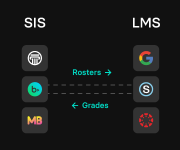|
|
 
|
Top Story
| |
 |
| (Monica Bertolazzi/Getty Images) |
Researchers have discovered nitrogen-fixing microbes under Arctic sea ice, challenging the belief that such life could not exist in these conditions, according to a study in Communications Earth and Environment. The microbes, known as non-cyanobacterial diazotrophs, could significantly alter nitrogen cycles and the marine food web as Arctic ice melts because of climate change. |
|
|
 | Stop Double Entry Between Your SIS and LMS
Flow automatically syncs classes, rosters, assignments, and grades between your Student Information System and Learning Management System. No more manual updates or duplicate work. Learn more about Flow. |
|---|
| |
|
|
 
|
Science in the News
Some South American dinosaurs could stand on their hind legs for extended periods, according to a study in Palaeontology. The study used computer models and finite element analysis to simulate how these dinosaurs managed this feat, revealing that Uberabatitan and Neuquensaurus had femurs that handled stress well.
| Full Story: Earth (10/28) |
|
|
|
Acoustic oceanographers have discovered a method for measuring ocean acidification using ambient wind noise, as detailed in the J ournal of Geophysical Research: Oceans. The method tested in the Mariana Trench, Tonga Trench and the Philippine Sea, estimates pH by analyzing how sound is absorbed as it travels through seawater. |
|
A study in JAMA Network Open suggests sleeping in total darkness may lower the risk of cardiovascular disease. Participants exposed to the brightest light at night had a significantly higher risk of heart failure, coronary artery disease and stroke. The study tracked nearly 89,000 people using wrist wearables to monitor light exposure. |
|
A study in PLOS One reveals thar Indigenous Americans at Cahokia transported a massive tree more than 180 kilometers to serve as a marker post around 900 years ago. Researchers used radiocarbon dating and strontium isotope analysis to determine the log's origin and timeline, providing new insights into Cahokia's rise and decline in Mexico. |
|
| |
 |
| (Catherine Falls Commercial/Getty Images) |
Women may need less exercise than men to protect against coronary heart disease, according to a study in Nature Cardiovascular Research. The study of more than 85,000 adults finds that women who engage in four hours of moderate exercise weekly lower their heart disease risk by 30%, whereas men need eight hours for similar benefits. |
|
A global study of more than 17,000 adults found that semaglutide reduced the risk of heart attack or stroke by 20%, even among those who lost little or no weight. Published in The Lancet, the research showed that smaller waistlines were linked to heart benefits, but about two-thirds of the drug's cardiovascular protection appeared to come from mechanisms beyond weight loss alone. |
|
|
 | The Future of Retail: What's Coming in 2026
AI personalization and seamless customer experiences defined 2025, but the retail landscape is about to shift again. Join us on November 5th for a fast-paced webinar where industry experts reveal the top trends and technologies shaping 2026. Discover how to stay ahead, boost productivity, and deliver next-level shopping experiences. Register now! |
|---|
| |
|
|
 
|
Funding Watch
|
The University of Nebraska at Omaha has received a $6 million NIH grant to support ongoing research in human movement variability. This funding will be used over five years to deepen understanding of neuromuscular adaptability and aid the development of therapies for movement disorders such as Parkinson's disease and cerebral palsy.
|
|
|
 
| Got this from a friend? Subscribe now and stay in the loop! |
| | | |
